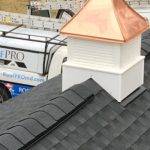When was the last time you thought about your attic? If you’re like most homeowners, it probably wasn’t all too recently – and if it was, it was probably only about what you have stored there. However, the attic is actually a critically important part of the house. Without the proper ventilation for your attic, you could be in for quite a bit of damage and money spent to rectify the situation.
For this reason, it’s best to understand the importance of installing soffit and ridge vents in your attic for the safety and well-being of your home!
The Soffit Vent
Soffit vents can be found under the eaves of a house, which typically overhang on the edge of the roof. These vents provide cool air to your attic, which can in turn help reduce the overall heat and moisture that may otherwise be present.
Not only does this keep things cool, but it also helps prevent things like mildew, mold, and wood rot, which can be quite expensive in the longterm if left unchecked.
With homes that have a vented versus non-vented soffit, it’s important to make sure that your baffles – which allow air to go all the way up to the attic – are working properly. Having a vented soffit without a baffle means that air will get trapped, and it will be unable to reach the attic.
Non-Vented Soffits
Of course, if you have an older home, you may have non-vented soffits. This version keeps all the air outside the home, rather than allowing cool air in. Non-vented soffits tend to keep your house warmer, which can be a real negative in the heat that Maryland homeowners deal with during the summertime! Not only does this impact comfort in the home, but it also drives up energy bills while trying to cool your home.
If your home is older or you’re simply not sure if you have a soffit vent, be sure to get a professional to check out your home. They’ll be able to tell you which kinds of soffits you have, and can point you in the right direction should you want to install vented soffits.
Ridge Vents
Another type of roof ventilation is the ridge vent. Typically found along the top of a sloped roof, the ridge vent allows for damp, warm air to leave the attic. This air would otherwise be stuck in the attic, which could decrease the life of your home’s structure.
Using Ridge And Soffit Vents Together
Together, soffit vents and ridge vents create a system that allows cool air to enter the attic and warm air to leave the attic. This ventilation system helps bring in air and lets it escape – and so the soffit and ridge vents are pretty dependent on one another to work correctly. After all, without a soffit vent, there would be no cool air brought into the attic, and without a ridge vent, there would be no way for the air to escape once it was warmed up!
Remember, having the proper ventilation is key when it comes to taking care of not just your roof or attic, but your entire home! Your RoofPRO technician will help you understand your entire home ventilation system before your soffit replacement starts.
How Soffits Fit Into Your Roof’s Ventilation and Protection Strategy
A soffit may look like a small component beneath the roof overhang, but it plays a big role in protecting your attic and improving energy performance. To see how it ties into the full structure, start with Parts of a Roof System. Then review how different vent types compare in the article on difference between gable, soffit & ridge vents, and the deeper comparison in ridge vents vs attic fans. You’ll also want to understand the continuous flow of intake and exhaust in soffit & ridge vents.
Because soffits often hide or support structural and mechanical components, reading about What You Should Know About Pipes on Your Roof helps you see how the underside of your roof functions. If you notice stains, sagging boards or insect access near your soffits, our article on How to Inspect a Leak From a Vent Pipe gives you practical indicators of issues in that zone.
If you’re ready to evaluate your soffits, vents and roof edge in one combined inspection, Reach out to our Maryland roofing experts and we’ll help secure your home’s structure and comfort.





